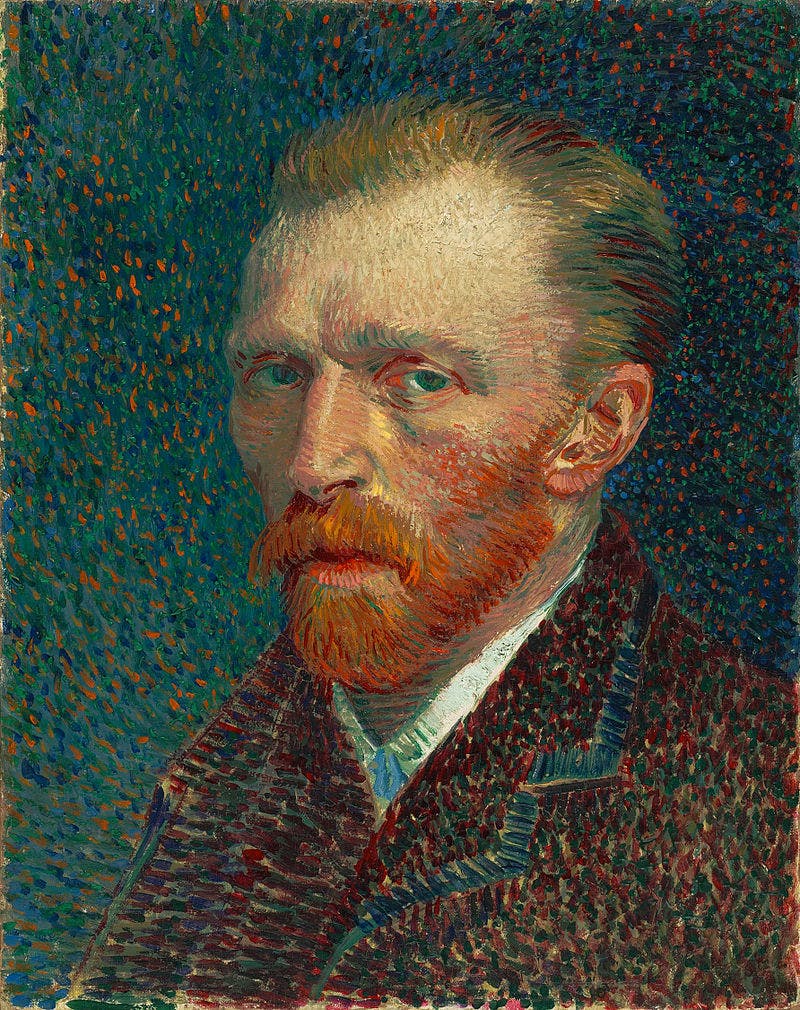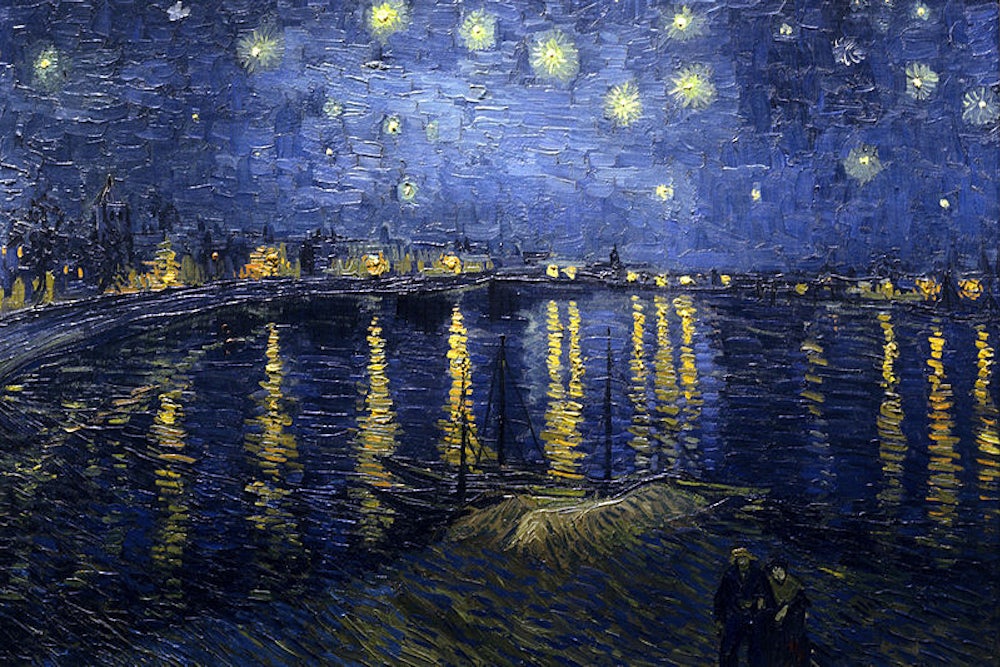The nineteenth century will perhaps be remembered as an age when the dwarfs and the giants banished the gods; when the Bismarcks and the Watts lived long in the land, whilst the finer spirits, the Nietzsches and Ruskins and van Goghs, perished in lonely madness. Dr. Max Nordau was not wrong when he characterized the spectacle as one of degeneration; his treacherous failure lay in his inability to see that the degeneration had taken place in society, rather than in those who were at odds with it. The madmen were the developed types, the musicmakers; and they were overwhelmed by debased and crippled people—the lamed Vulcans of one mythology, or the vicious, dwarfish smiths and metallurgists of another. In the biographies of Friedrich Nietzsche and Vincent van Gogh we read the tragic story of two men whose quest for a life abundant ran flat against the spirit of the age, goods and of the sleek parasitism that was its final destination and fulfillment.
Vincent van Gogh was born in 1853 and died in 1890. He was born mid the meadows and orchards of Brabant, in the Lowlands, and he grew up in the midst of a rural society where men still turned over the earth and scattered the seed in the furrows, punctuating each beat in the rhythm of nature with an appropriate deed. Shy, humble, withdrawn, he accepted the lot in life belonging to a family with mercantile connections, and at sixteen, without any definite inclinations towards art, he found himself an apprenticed picture dealer in the Goupil Galleries, first at the Hague, and then in Paris and London. At this trade Vincent lost none of his gnarled, deep-rooted intelligence; on the contrary, he acquired convictions about art which were not always in harmony with fashion; and presently we find Vincent leaving the business of art to his life-long friend end comrade, his brother Theo.

Vincent’s father was a minister, and the Bible had seared Vincent’s heart with that peculiar intensity which it exercises over the lonely Protestant in northern lands, where virtue envelops the soul like a fog, and cuts one off from the sanity of fellowship with any other being than one’s God. Vincent entered the service of the church as a lay preacher, among the miners of La Borinage, in Belgium. He preached; he taught; he visited the sick; he shared the miserable existence of these crude, honest folk; and, as Herr Meier-Graefe tells us in his biography, “he gave away his money, his clothes, and at last even his bed.” Perhaps he sympathized with these miners, too, when they went on strike; at any rate, he took the precepts of Christ a little too seriously for the perfectly bourgeois directors of his church; and he was dismissed.
These strained and searching months at La Borinage were not wasted. In the muck and disease and starvation of this mining town, Vincent found himself; the seamed and knotted faces of his companions in misery awakened the artist in him, and slowly, the man who had wandered about, idle, seeking, as he might have put it, God’s word and God’s work, began to draw and paint. During the next ten years or so of his life his spirit was in continual travail; and out of it his pictures came forth.
The technical development of van Gogh’s art does not concern us here; one merely notes in passing his first debt to the painters of his own country, his awakening to color among the impressionists at Paris, and finally, emerging out of this, the brilliant palette, and the firm, slashing strokes of van Gogh’s mature art, equally clear and impassioned, whether it touched a few articles of furniture, a cypress in an open field, or a man’s head. One understands his art better by its many contrasts with that of Gauguin, that stanch boulevardier who sought the primitive in the South Sea Isles, where one might find it in a musical comedy, instead of seeing that it was a quality of life, which one might discover in the plowed fields of one’s native countryside, Gauguin, it is true, knew the life of culture better than van Gogh, and he saw that art might find a habitation in our buildings once more, in the flat tones of decoration. Van Gogh, however, had a fund of spiritual energy which Gauguin lacked: he sympathized where Gauguin only saw, with the result that there is an intensity of experience in some of his pictures which in Gauguin, one sometimes feels, is only a firmness of intention.
It comes to this: van Gogh was not merely a painter of tremendous force and originality; he was above all things a man who thought and suffered, and out of the biting ecstasy of his life he created pictures which seem to tell us what a vivid world we might find if only, like Vincent himself, we would leave behind what we call our centres of civilization, and renew once more our contact with real landscapes and real people, instead of drifting through the pall of shadowed buildings and shadowy lives that now overwhelm us. In one of his letters van Gogh says of Christ; “He lived serenely as an artist, as a greater artist than any other; for he despised marble, clay, and the palette, and worked upon living flesh. That is to say, this marvelous artist, who eludes the grasp of that coarse instrument, the neurotic and confused brain of modem man—created neither statues nor pictures nor even books.... he created real, living men, immortals.” One can read beyond this the deep intention of van Gogh’s own art: could he have rent his body and mind for smaller aims?
Figure the painter, van Gogh, during the last years of his life, in the glare of the Mediterranean sun at Aries; living in a house where white and blue and yellow and green leap out of the forms of chairs, blankets, and crockery, without suffering from the tepid gradations which derive from dust and mist. What Wordsworth felt when he saw the daffodils in spring, van Gogh can feel when be looks at the shimmering fields of wheat, the orchards, or the yellow mairie. In old Provençe the country is at one’s doorstep; the town is merely a place where men chaffer, and rest from their day’s labor. One can be a painter here without strain; the very postman shows what a sympathetic and intelligent fellow he is—he poses for one, he becomes a friend. Even the bawdy house is a merry place; the friendly sensuality of the south is not the ugly and necessitous thing called vice in the towns of the north.
Two years pass in a tumult of impressions and interpretations; van Gogh works and enjoys beauty to the full; Gauguin, with whom he had been exchanging pictures because, forsooth, the public will have neither of them, comes to join him; they keep house together; they paint; they test each other’s metal and at times strike the fire of hatred or misunderstanding. The life is abstemious to the point of saintliness; here is devotion to art which will make the Philistines shudder with horror in one age, and buy up the pictures, in rapture, in the next. What is the formula? Van Gogh answers: “The healthy man should be able to live on a piece of bread and keep at work all day. He should also be able to bear a pipe of tobacco and a good drink; for without these things nothing can be done. And withal, he ought to have some feeling for the stars and the infinite heavens. Then it is a joy to live.”
Van Gogh dreamed of a dedicated life; but he knew the vacant qualms of solitude, as well as the perils of domesticity; and while he saw that “if we wish to keep our strength for our life work we must have only very little to do with women,” he was not content to be a hermit and an outcast. He looked forward to founding a community of painters, aiming at the best art possible; in short, he sought to revive, directly and simply, without formal organization, the corporate life which had been the environment of art and culture during the Middle Age; he looked upon his fellow craftsmen as brothers of the guild of St. Luke. “I grow ever more and more convinced,” he said, “that the pictures which will be necessary and inevitable if painting is ever to attain to the serene heights of Greek sculpture, German music, and French fiction, will be beyond the strength of the individual. They will therefore have to be executed by a group of painters, who will collaborate in order to carry out an idea which they hold in common.” Gauguin laughed aloud at this project; even Theo, Vincent’s dear, helpful brother, was sceptical; still, the notion persisted, and to Theo’s credit, he spent the last six months of his life, following Vincent’s death, in trying to give it a foundation.
I will not dwell on Vincent’s end; his insanity was an event in the physical world, and not within the domain of art. It is enough to say that friendship and understanding and a local habitation for his Beloved Community did not respond to the call of this solitary artist; and the great spirit within him took a terrible revenge for its long frustration. In his last letter to Gauguin, from Auvers, Vincent said: “It is more dignified to die while I am fully conscious of what I am doing than to take leave of the world in a state that degrades me.” He died at his own command, and retreated calmly to the cloister where even the demented have peace.
There are two parts to a great life, the history and the philosophy, the daily record of events, and the achievement; and Herr Meier-Graefe’s work is, on the whole, richer in the first department than in the second. These two volumes, with their mass of illustrations, are a credit to the printer’s art; only, since obviously no expense was spared in their preparation, it is unfortunate that they contain not a single reproduction in color of van Gogh’s work. As biography, despite the vivid dexterity of the translator, one feels a certain incongruity in the swift, matter-of-factness of Herr Meier-Graefe’s narrative; for there are times when his account seems to reduce van Gogh’s stature. I have a sense that van Gogh’s own letters leave not merely a truer impression of his mind and his art, but a greater one. Still, except for the Letters of a Post-Impressionist (Houghton, Mifflin, 1913) the present biography stands alone; and one welcomes it as an example of what good writing, good translation, and good printing can produce. The spirit of van Gogh will some day find a St. Luke, who will give us the gospel of a man who was, for the nineteenth century, the crucified scapegoat. That story will answer one of the questions that used to puzzle the age—what would happen to a Christ if he walked again on the earth?
This is a review of Vincent van Gogh: A Biographical Study, by Julius Meier-Graefe, translated by John Holroyd Reece and published in Boston by The Medici Society Limited, 1923.
